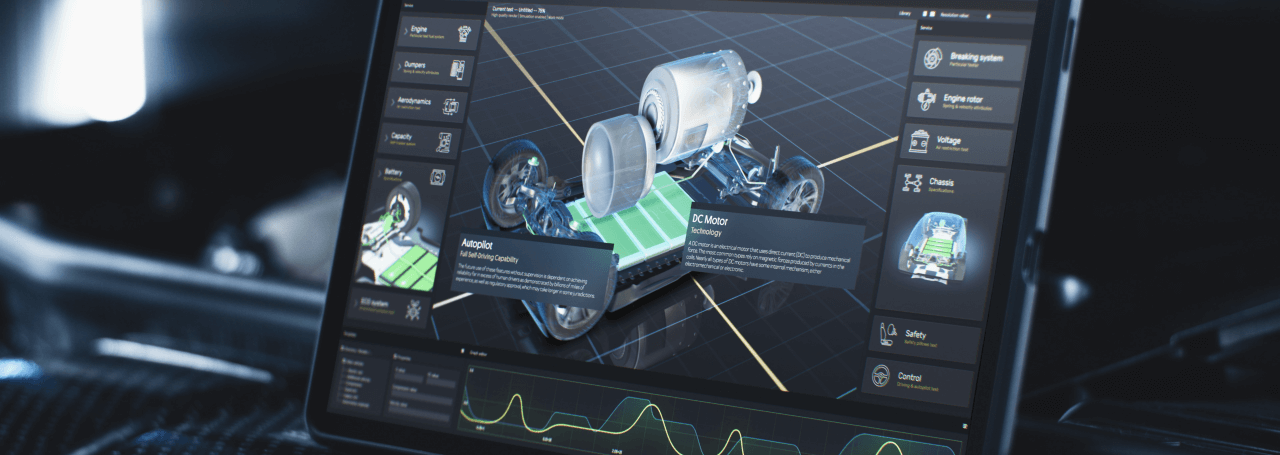- Introduction to OLED screens
- What is an OLED display?
- Comparison between a TFT displays and an OLED displays
- Passive Matrix OLED – PMOLED and Active Matrix OLED – AMOLED
- What are advantages of OLED displays?
- What are disadvantages of OLED displays?
- Lifetime of OLED displays
- Proper applications of OLED displays
- PMOLED – Passive Matrix OLED Display
- Comparison of OLED, STN and VFD displays
- OLED vs STN vs VFD
- AMOLED – Active Matrix OLED display
- What is Super AMOLED display?
- Interfaces in OLED displays
Welcome to Riverdi University. In this lecture we will be talking about OLED displays. OLED displays are a little bit different than the TFT displays that we normally sell and Riverdi does not sell standard OLED displays. We sell them as custom modules only for particular projects. So, if you require an OLED display in your application, please contact us and for sure we will be able to find a solution for you and make the right display. Anyway, because we share the knowledge about displays, we have today’s University lesson about OLEDs because it is important to understand how they work and how to use them and just acknowledge this fantastic technology that exists and for sure in the future we will have standard displays based on OLED technology as well.


Introduction to OLED screens
In the picture above we have a short agenda of the lecture. We will talk about basic rules, how OLED displays are built and how they differ from TFT modules. Then a little bit about physics and about application rules, how to use OLED displays. We will also talk about passive OLEDs, we will see the comparison between OLED technology and STN, which is a monochrome LCD, and a VFD which is the Vacuum Display. Vacuum Display is an old technology, but we can find some displays on the market that still use this this technology. We will talk about Active OLEDs that are AMOLEDs and Super AMOLEDs and last, we will talk about interfaces for OLED displays.
and just acknowledge this fantastic technology that exists and for sure in the future we will have standard displays based on OLED technology as well.
What is an OLED display?
OLED is abbreviation from Organic Light Emitting Diode. It is like LED but based on organic materials. The emitting light is pretty much the same as with the LED, just the materials used here are different. They are not silicone based but organic based layers. As you can see the structure and construction is pretty simple, the physics here is like in any LED diode or laser diode. We have the recombination of electrons, so with the current they go to the higher levels energy states and then they go to the lower levels and emit light. Using various materials, we can generate distinct colors, and this is different than in TFT.
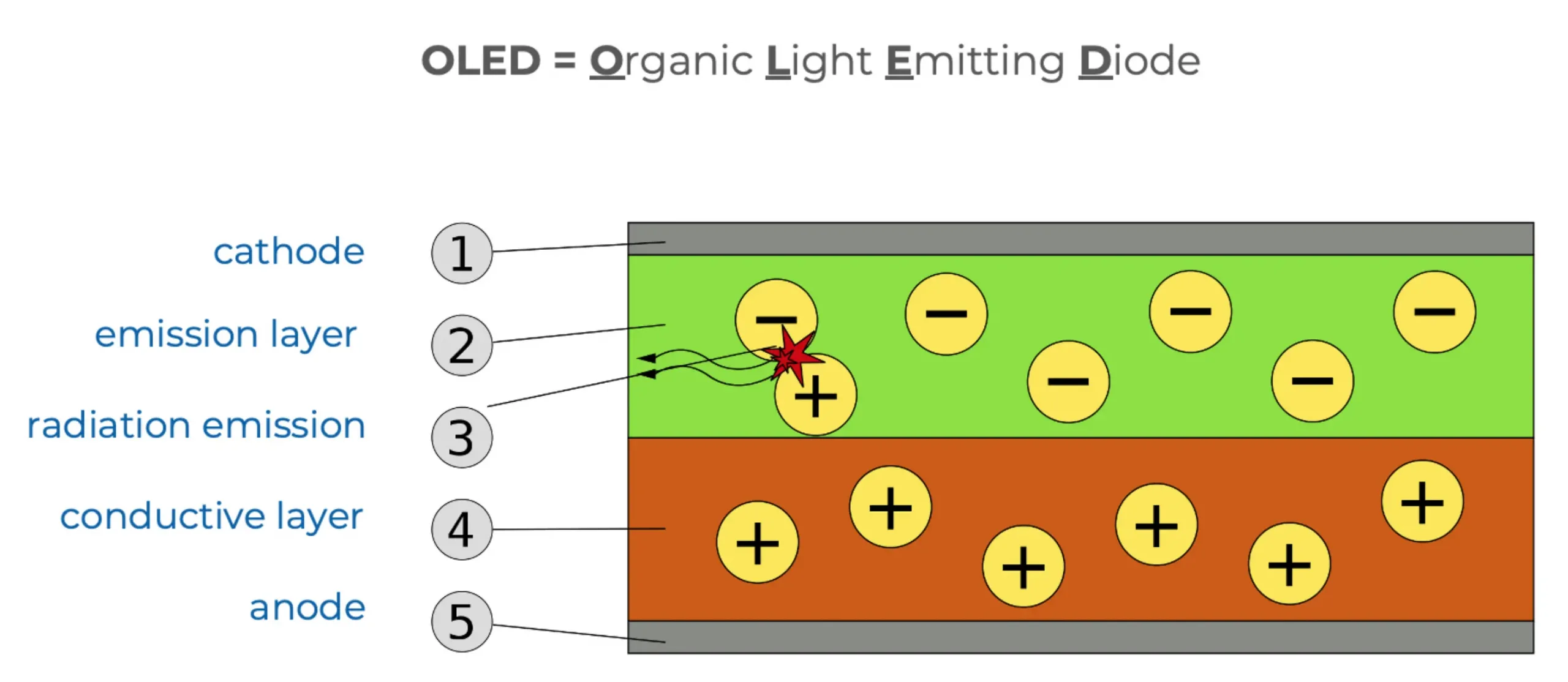

As you may remember from our TFT sessions, we said that TFT or LCD in general is just blocking the light from the backlight. Usually, the backlight in TFT is white. We block the light, or we transmit the light and to achieve the color in TFT we need to use color filters. Normally there are three color filters on the top of the TFT screen, which are RGB. For OLED screens it is different. We have a material that emits the color itself. So, using varied materials, we can emit distinct colors. If we have a full color OLED display which will typically be an AMOLED display, that you can see nowadays in mobile phones or tablets or even laptops or TV sets, it uses RGB cells or RGBW cells and then the colors are mixed. Remember that the OLED is emitting light itself, and we do not have any backlight.


Comparison between a TFT displays and an OLED displays
In the picture above, you can see a simple comparison between a TFT display and an OLED display. The first thing that is always noticeable is that OLED display is much simpler. We have less layers than in a TFT. As you may remember from the TFT lecture it is pretty complicated. At first, we need a backlight, then we need some diffusers, light guides to prepare the light, we have polarizers, we have a TFT itself, which is simplified in the picture, and then we have color filters and the top polarizer. With OLED the construction is very simple. We need a base as the backbone for every display, then we have the emission layer and some conductive layers on the top and the bottom.
Passive Matrix OLED – PMOLED and Active Matrix OLED – AMOLED
A passive display – PMOLED is very simple compared to an LCD monochrome display. An Active Matrix – AMOLED is more like a TFT and we additionally have transistors in the cells. But in the simplified version we do not have transistors, just simple layers and there is no color filters and no backlight. So, we have no back and no front layers, just the middle that is emitting light itself, and this gives us a really big advantage. Of course, it is simpler, it may be cheaper to build in mass production OLED displays, but if we do not have a backlight, that means if we do not emit any light, we have a true black background and this is a huge advantage of OLED displays, where we have a contrast in very high values. OLED displays are perfect displays to achieve high contrast. If we do not have reflected light or if we decrease the reflected light, we do not have the light that is coming from the backlight, because there is no backlight. If you have ever seen an OLED display, especially in a TV store, you could see OLED TV sets, from LG or Samsung or other brands, and you may notice that the contrast there is very high and the black is true black. It is even an unnatural thing to see that. The companies there use special demo movies where we have like the cosmos or something and the sun in the middle of the screen. You can see that the background is black, and it is true black. It is different than in TFT displays. If you have a TFT display next to the OLED display, you will notice the difference. The contrast in OLED is much higher because there is no backlight and no issue with the light that is going through TFT always, a little but always, that is the main difference.
What are advantages of OLED displays?
In the picture above, we have the main advantages of OLED displays. We have excellent contrast, very high contrast. As you can see the background is really black and it looks like that in reality, not only in the photo. No backlight, high brightness, we can achieve pretty high brightness of the pixels in OLED, we have fantastic color reproduction, because we do not use color filters, we are able to generate very saturated colors in a wide gamut. Typically, OLEDs have the widest gamut color on the market, and it is really superior to a typical TFT


We can also achieve this with a TFT, with special color filters or Quantum Dot filters, but in general OLED is superior here without any special effort. The true black is related to the contrast. Super viewing angles, that is another advantage over the TFT. If we have a typical TFT, a TN display discussed in the previous lectures, we have grayscale inversion from one viewing angle. Then we have displays like IPS or MVA types, where we can see a picture from all the viewing angles but still the viewing angle would be like 85 degrees 87 or the best would be up to 89 degrees. In OLED displays we have 89 degrees without any effort because it is like a LED diode. It emits light, and we can see exactly the same from all the viewing angles. OLEDs can be very thin, because there are only a few layers, no backlight, no front layers, so they can be very thin and very light. We can build OLED displays on elastic surfaces that we can bend or can be curved, for example Samsung foldable mobile phones or some curved LG TV sets. OLEDs have low power consumption. If we have an LCD or a TFT, we need a backlight. The backlight is consuming a lot of power because the light is being consumed by all the layers that the TFT has: the polarizers, the color filters, diffuser; everywhere we lose a little bit of power from the backlight, so we need a lot of power to really have bright TFT. With OLED we have just a straight light from the pixels itself, so the power consumption can be low and lower than in a typical LCD. And we have a very wide operating temperature. We can go as low as -40 with OLED. There are no mechanical issues like with the LCD where we have liquid crystal inside the cell that in low temperature can become close to solid and cannot move anymore. Typically for TFT we have –20, -30 degrees, in some exceptional cases we have –40, but for OLED it is no problem to work even in -40 degrees. On the other hand, with high temperatures, you need to be careful because it decreases OLED lifetime, so you need to check in a spec or contact manufacturers if you require high temperatures for OLED. If it is for short periods, then it is fine, but if your OLED display need to work constantly in a high temperature, like 50, 60 or 80 degrees, then it is worth to check how it will affect the lifetime of OLED display.
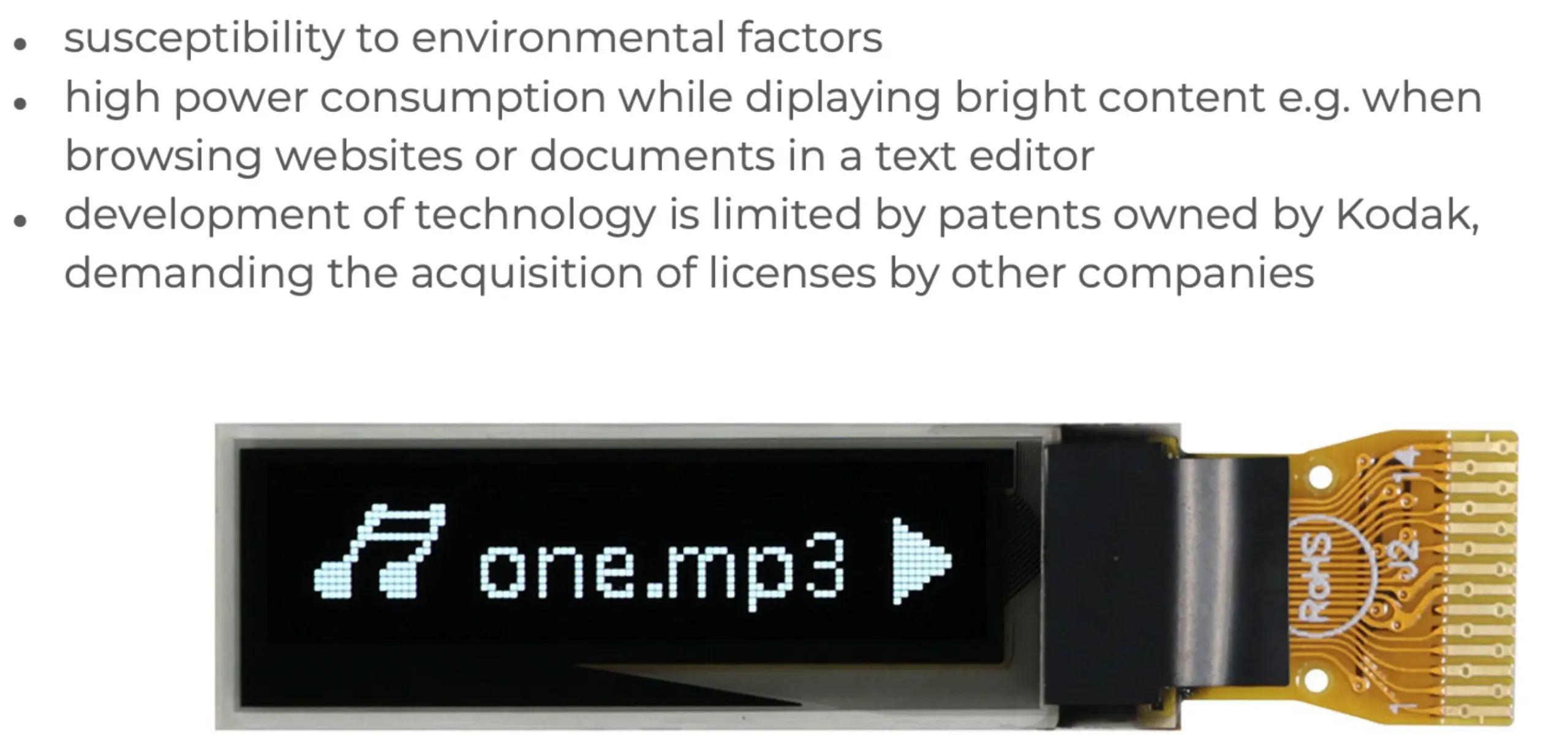

What are disadvantages of OLED displays?
Now let us look at some disadvantages. In industry OLED technology is not very widely used apart from consumer products. In mobile phones, tablets, laptops we already have a lot of use cases. In industrial applications it is still a growing market, but not very mature. Some of the problems are related to the patents, that is why we are still waiting for the mass adaptation of OLED displays. We may have a higher power consumption, especially if we have a full white background then we need to power all the pixels and the power consumption can sometimes be higher than the TFT. So, there are only a few disadvantages, and they are minor in our case.
Lifetime of OLED displays
In the picture above there is a chart from our partner Winstar company from Taiwan. As you can see, they measured how long the OLED display can work. In the past, around 10 years ago, there were problems with OLED displays. The first OLED displays on the market had a very short working lifetime. It was like 10k hours, 10 000 hours and the problem was, that the brightness of them decreased even when they were not used, were just on the shelf. The first OLEDs had a lot of issues but later the process was improved, particularly by Winstar, they did a lot of work to really extend the lifetime of OLED displays.




Here we have some calculations and report where Winstar used the higher temperature to speed up the process and the result from the calculation is around 100 000 hours, so 100k hours which is very long. For industrial TFT displays we typically have 50 000 hours of lifetime. The lifetime is calculated until the display has a half of the initial brightness. When you say the display is 50 000 hours lifetime it does not mean it will be dead after 50 000 hours, it means that the average brightness will be in a 50%. For OLEDs it will happen after the 100 000 hours which is a very long time, it is like 15 years of continuous 24-hour work. If we sometimes switch off our OLED display, which is the normal use case in most industrial applications, we can expect the display to work even over 15 years. So, the lifetime nowadays with a good manufacturer like Winstar is not a case anymore.
Proper applications of OLED displays
Now let us talk about proper applications of OLED displays. With the TFT we have a backlight. If the backlight decreases in brightness, the whole display decreases in brightness. With OLEDs we have like every pixel is a backlight, it is emitting light. If we have a lot of pixels next to each other, and we use them, the brightness decreases in according to used time. So, if we have a pixel that is switched on longer than the next pixel, the first pixel will have a little bit lower brightness after some time. In the picture above, you can see two pixels that are moved aside. We cannot see a big difference between them, because they are moved aside. The human eye cannot recognize the brightness very well. We cannot tell what the brightness level of a separate thing is, but we are very good at comparison, and when we move the pixels next to each other we can clearly see the difference between them. This is the case of OLED display that if we have two pixels next to each other there may be some problems, that after some time some of them will have just a little bit lower brightness and we can see the difference.






It is calculated and the threshold value of the contrast where we can see the difference between two pixels that are next to each is called the Weber coefficient.
In the picture above, we have a real example. If we have an OLED display and normally, we have a watch there that shows the time, we have the arrows moved around and we have the circle and most of the time we have this image, then after some months or years of usage we may have a situation where the circle brightness will decrease a little bit. Of course, this image is especially prepared to show it strongly, the arrows will have a little bit higher brightness, but still a little bit lower than the normal, the background which was not used so often. This is something that we may see on OLED displays after some time. The use case here would be switching the colors. We can switch the background to be like in a negative way, for one hour we have a watch like on the picture, and for another hour we turn the background on and then we switch off the watch itself, so we try to keep the pixels in ON state the same time. It is not very important in most of cases, you do not need to be worried about that, but if you have i.e., 24 hours information in some place of your display, you may want to move it from time to time and use the entire display all the time of using. Another way is to implement a controller that uses a grayscale. This is more complicated; we need to calculate the time of the pixels where they were switched on and increase the brightness in this area to keep the display brightness the same all the time.


PMOLED – Passive Matrix OLED Display
In the picture above, we have a real example. If we have an OLED display and normally, we have a watch there that shows the time, we have the arrows moved around and we have the circle and most of the time we have this image, then after some months or years of usage we may have a situation where the circle brightness will decrease a little bit. Of course, this image is especially prepared to show it strongly, the arrows will have a little bit higher brightness, but still a little bit lower than the normal, the background which was not used so often.
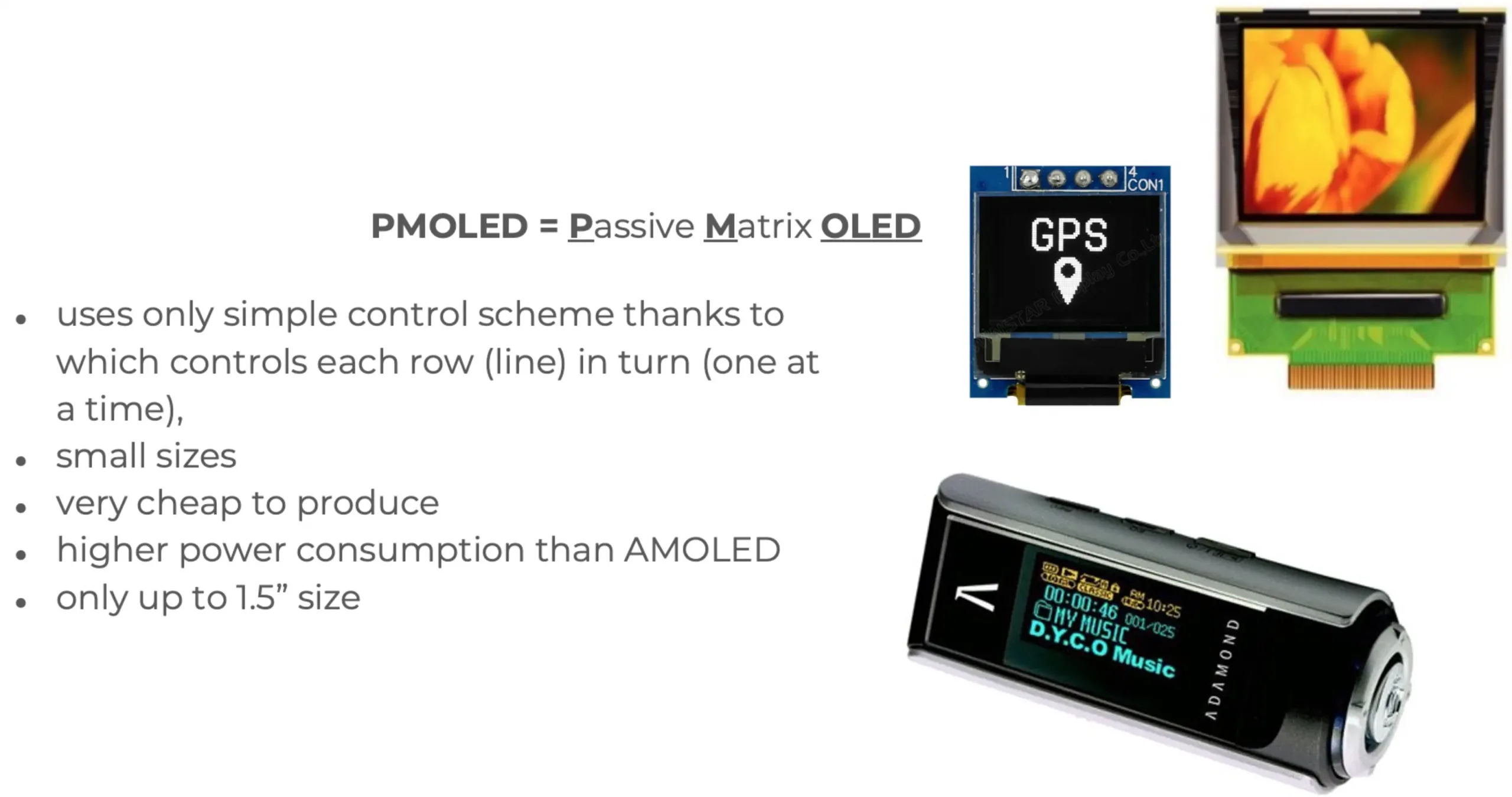

This is something that we may see on OLED displays after some time. The use case here would be switching the colors. We can switch the background to be like in a negative way, for one hour we have a watch like on the picture, and for another hour we turn the background on and then we switch off the watch itself, so we try to keep the pixels in ON state the same time. It is not very important in most of cases, you do not need to be worried about that, but if you have i.e., 24 hours information in some place of your display, you may want to move it from time to time and use the entire display all the time of using. Another way is to implement a controller that uses a grayscale. This is more complicated; we need to calculate the time of the pixels where they were switched on and increase the brightness in this area to keep the display brightness the same all the time.


Comparison of OLED, STN and VFD displays
Let us see now the comparation between the passive OLED typical OLED, STN monochrome LCD display and VFD Vacuum Fluorescent Display which is an old technology. As you can see in the picture above the structure of OLED is very simple, just one layer, just base glass, and that is it. In the STN we have a lot of layers we need the backlight we need the polarizers we need more layers, so it is much more complicated. OLED is very simple, it can be very thin and below we have a photo of how it looks.
OLED vs STN vs VFD
We can see the OLED, STN and VFD and we see them from different viewing angles. The OLED display is the winner, it has the best contrast and the best viewing angles, so it is a perfect display from the optical point of view. As you can see, on STN display from some angles we are not even able to see the image. It will be similar if we go to the TFT displays. That is why we need to use technologies like IPS to see the image from all viewing angles. For OLED we have it just like that, without any effort.




AMOLED – Active Matrix OLED display
The next OLED type after PMOLED is AMOLED. AMOLED means Active Matrix OLED. Similarly, like going from STN monochrome displays to TFT displays, to the active LCD displays with the LCDs, we add transistors in every pixel. So, the substrate layer, the backbone of the AMOLED display is practically the same as in TFT. We have transistors that are switching the pixels on and off, but we do not have liquid crystals. Instead of liquid crystals we put organic light emitting layers on top and we switch the diodes on top of this on and off. So, the technology is similar to the TFTs and that is why investing in tooling and making a new display is so expensive, it is comparable to the to the TFT.
On the picture above there are some first devices that were on the market over 10 years ago or 15 years ago with the AMOLED displays and the example of modern elastic OLED. That is the future, and we hope to see in the future a completely foldable or rollable display.
What is Super AMOLED display?
Then we have the Super AMOLED. The first Super AMOLEDs were called…
like that because of the in-cell touch. Normally we have OLED layers which emit the light, but we do not have the touch, we need to add it. With the TFT it is done by the additional layer, but with Super AMOLED we can put the touch screen in the cells. We add additional connectors, we add the sensing electrodes, and we have the touch sensor in the display. This is more cost efficient. If we know that our OLED display will be always used with a touch screen, which is the case of mobile phones or tablets, then adding this decreases the cost, we just need to add the cover glass on top and laminate it.
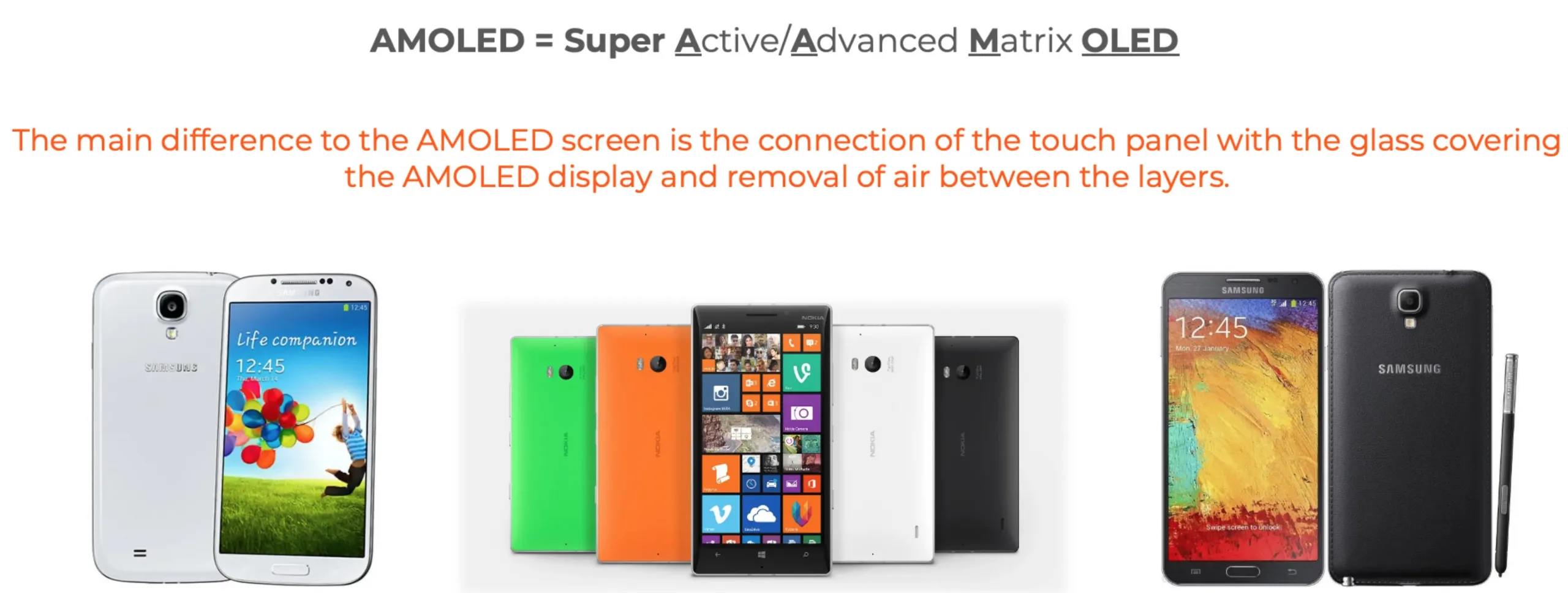

Interfaces in OLED displays
Now we know a lot about the PMOLED, AMOLED and Super AMOLED. Let us talk about interfaces. We have a separate lecture about display interfaces that you can find here , now we just focus on OLED displays. For passive matrix OLED displays typically we have I2C, SPI or old parallel interfaces, because they are slow, they are general purpose interfaces and require a memory in the display itself. We just sent simple information about switching the pixel on and off and sometimes the grayscale. If we go to the AMOLED, we rather require a video from a display and we also require all the colors, etc., so we have a lot of information to be sent and the interfaces there are like MIPI, DSI or RGB for some industrial use cases. The most AMOLED color displays on the market will have MIPI, which is a standard for mobile phones and tablets or even laptops and then we need to send a new frame 50 or 100 times per second, the same with LVDS interface.


DISCOVER OUR
Whitepaper
Achieve the perfect user-display interaction with the right Touch Sensor IC. Ever faced issues with phantom touch events or certification? Boost your R&D like a pro with our Whitepaper!

